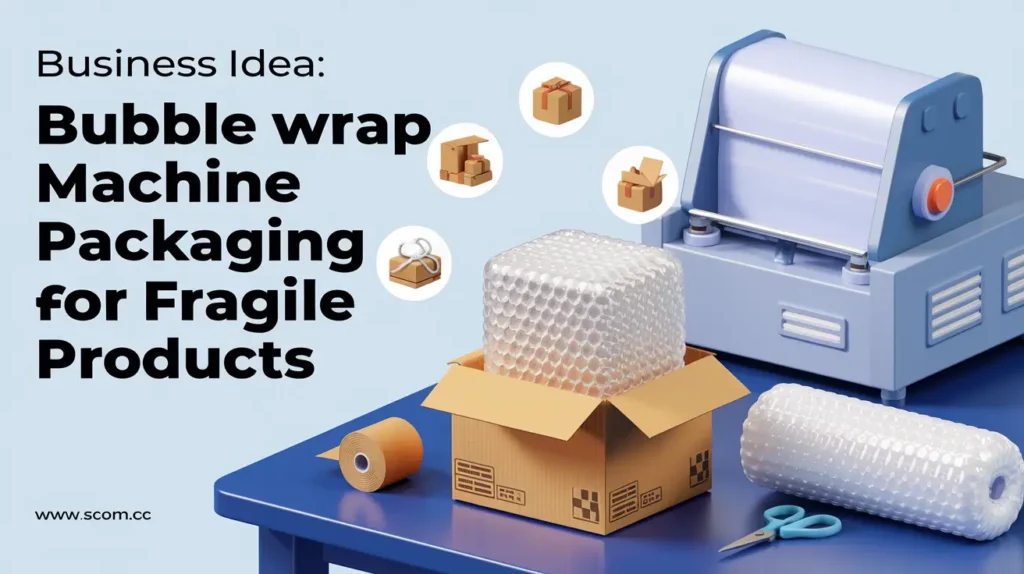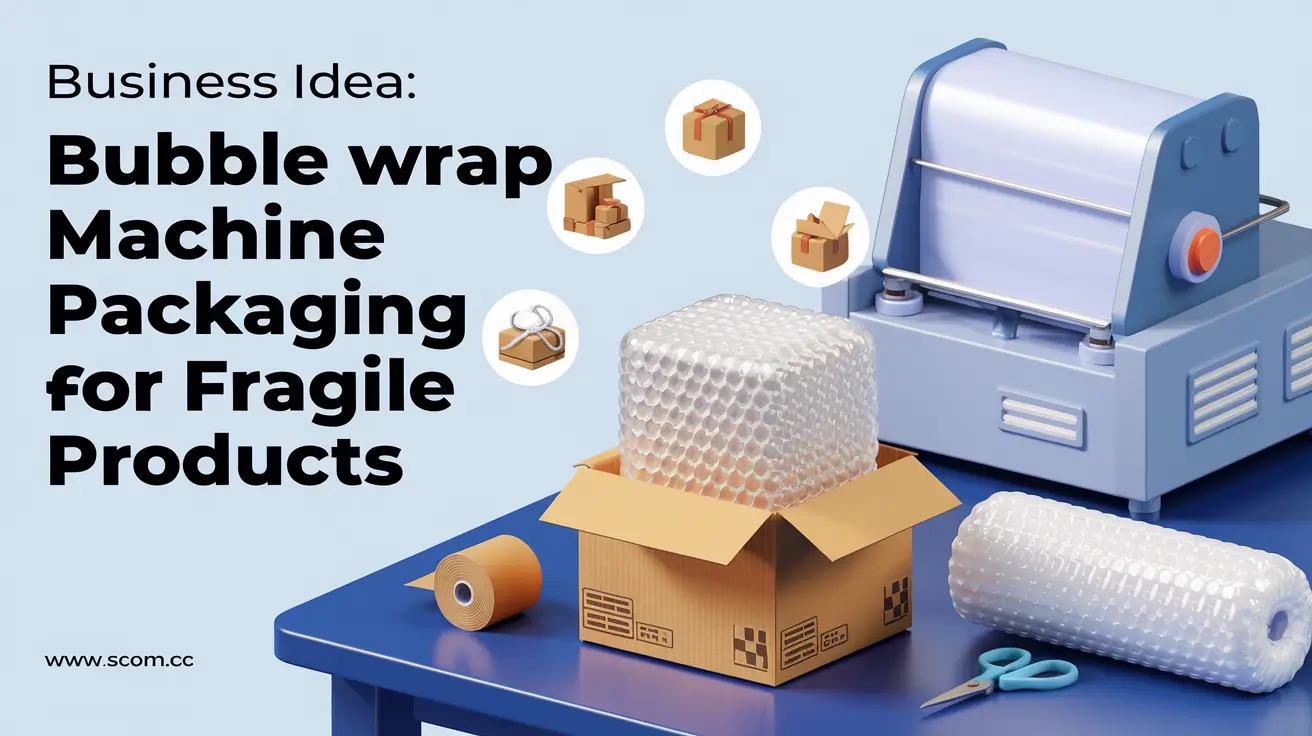Bubble Wrap Machine Revolutionizing Packaging for Fragile Products

- Bubble Wrap Machine Revolutionizing Packaging for Fragile Products
- What is a Bubble Wrap Machine?
- Market Potential for Bubble Wrap Machines
- Initial Costs and Equipment
- The Production Process
- Market Opportunities and Applications
- Marketing and Sales Strategies
- Quality Control and Compliance
- Scaling Your Business
- Financial Management and Profitability
-
FAQ
- What is a bubble wrap machine?
- How much does it cost to start a bubble wrap production business?
- What are the main applications of bubble wrap?
- How do I choose the right bubble wrap machine?
- How do I maintain a bubble wrap machine?
- Can I customize bubble wrap with logos or designs?
- What are the benefits of producing bubble wrap in-house?
Bubble Wrap Machine Revolutionizing Packaging for Fragile Products
In the world of packaging, ensuring the safe transport of fragile products is paramount. One effective solution is the use of bubble wrap, which provides cushioning and protection against damage. Investing in a bubble wrap machine can transform the efficiency and cost-effectiveness of your packaging operations. This business idea explores the benefits, market potential, and practical considerations of using a bubble wrap machine to produce high-quality bubble wrap for various applications.
What is a Bubble Wrap Machine?
A bubble wrap machine is a specialized device designed to produce bubble wrap for packaging purposes. This machine extrudes plastic film and creates bubbles through a process of air injection, resulting in a flexible, cushioning material ideal for protecting fragile items during shipping and storage.
How Bubble Wrap Machines Work
- Material Extrusion: The machine melts and extrudes plastic resin into a thin film. This film is then inflated with air to create the bubble pattern.
- Bubble Formation: Air is injected into the film through small holes or nozzles, forming the characteristic bubbles that provide cushioning.
- Cooling and Cutting: After bubble formation, the material is cooled and cut into the desired size or roll length for use in packaging.
Market Potential for Bubble Wrap Machines
The demand for bubble wrap in the packaging industry is substantial, making bubble wrap machines a valuable investment. This market includes various sectors that require reliable and cost-effective packaging solutions.
Key Market Segments
- Packaging and Fulfillment Companies: Businesses involved in packaging and shipping fragile items benefit from bubble wrap machines, as they can produce their own protective materials in-house.
- E-Commerce: Online retailers require efficient packaging solutions to ensure the safe delivery of products to customers.
- Manufacturing and Distribution: Industries that handle delicate or breakable goods need bubble wrap to safeguard their products during transportation and storage.
Potential Revenue Streams
- Custom Packaging Solutions: Offer custom-sized and custom-printed bubble wrap for specific client needs, enhancing your product's appeal.
- Bulk Production: Produce large quantities of bubble wrap for wholesale distribution to packaging companies and retailers.
- On-Demand Manufacturing: Provide on-demand bubble wrap production for businesses that need flexible packaging solutions.
Initial Costs and Equipment
Starting a bubble wrap production business involves several key investments, with the initial cost primarily focused on acquiring the machine and associated materials.
Initial Cost Breakdown
- Bubble Wrap Machine: Prices for bubble wrap machines start at around $300, with variations based on size, capacity, and features.
- Plastic Resin: Purchase plastic resin in bulk for extrusion. Costs vary depending on the type and quantity of resin used.
- Maintenance and Supplies: Budget for regular maintenance, replacement parts, and additional supplies such as air compressors or cooling systems.
Optional Investments
- Upgraded Machinery: Invest in advanced models with additional features, such as adjustable bubble sizes or integrated cutting mechanisms.
- Packaging and Storage Solutions: Acquire equipment for packaging and storing the finished bubble wrap to streamline your operations.
The Production Process
Understanding the production process is crucial for maximizing efficiency and ensuring high-quality bubble wrap. Here’s a step-by-step guide to creating bubble wrap using a machine.
Step 1: Preparing the Material
- Selecting Resin: Choose the appropriate type of plastic resin for your bubble wrap, considering factors such as strength, flexibility, and bubble size.
- Loading the Machine: Load the resin into the machine’s hopper or feed system according to the manufacturer’s instructions.
Step 2: Extrusion and Bubble Formation
- Extruding Film: The machine heats and melts the resin, extruding it into a continuous film.
- Inflation: Inject air into the film to create bubbles, adjusting the pressure and flow rate to achieve the desired bubble size and density.
- Cooling: Allow the bubble wrap to cool and solidify before proceeding to the cutting stage.
Step 3: Cutting and Rolling
- Cutting: Use the machine’s cutting mechanism to trim the bubble wrap into sheets or rolls of the desired size.
- Rolling: Roll the finished bubble wrap for storage or packaging, ensuring it is neatly wound and ready for distribution.
Step 4: Quality Control
- Inspection: Regularly inspect the bubble wrap for consistency in bubble size, film thickness, and overall quality.
- Adjustments: Make necessary adjustments to the machine settings to address any issues or improve product quality.
Market Opportunities and Applications
Bubble wrap has a wide range of applications across various industries. Identifying and targeting key market opportunities can help maximize the potential of your bubble wrap machine business.
Common Applications
- E-Commerce Packaging: Use bubble wrap to protect items during shipping, reducing the risk of damage and enhancing customer satisfaction.
- Retail and Wholesale: Supply bubble wrap to retailers and wholesalers for use in their packaging operations.
- Industrial Use: Provide bubble wrap for use in manufacturing and distribution processes, protecting products from damage during handling and transport.
Potential Niches
- Custom Bubble Wrap: Offer custom-printed bubble wrap with company logos, promotional messages, or unique designs for added branding opportunities.
- Eco-Friendly Options: Explore eco-friendly materials and processes to appeal to environmentally conscious customers and meet sustainability goals.
Marketing and Sales Strategies
Effective marketing and sales strategies are essential for building a successful bubble wrap production business. Here’s how to promote your products and attract customers.
Online Presence
- Website and E-Commerce: Create a professional website showcasing your bubble wrap products, pricing, and ordering options. Consider setting up an online store for direct sales.
- Social Media: Use social media platforms to share information about your products, industry news, and special offers. Engage with potential customers and industry influencers.
Offline Marketing
- Industry Trade Shows: Attend packaging and logistics trade shows to showcase your bubble wrap products and network with potential clients and partners.
- Local Advertising: Advertise in local business directories, newspapers, or industry magazines to reach potential customers in your area.
Sales Channels
- Direct Sales: Build relationships with packaging companies, e-commerce businesses, and other potential clients to secure direct sales agreements.
- Wholesale Distribution: Establish wholesale partnerships with retailers and distributors to expand your reach and increase sales volume.
Quality Control and Compliance
Maintaining high quality and compliance with industry standards is crucial for building a reputable business and ensuring customer satisfaction.
Quality Assurance
- Product Consistency: Ensure that your bubble wrap consistently meets quality standards in terms of bubble size, film thickness, and overall performance.
- Regular Testing: Conduct regular testing and inspections to identify and address any issues with the production process or final product.
Compliance and Regulations
- Safety Standards: Ensure that your bubble wrap production processes comply with relevant safety standards and regulations.
- Environmental Regulations: Adhere to environmental regulations regarding the use of plastic materials and consider implementing eco-friendly practices where possible.
Scaling Your Business
As your bubble wrap production business grows, consider strategies for scaling operations and expanding your market reach.
Increasing Production Capacity
- Additional Machines: Invest in additional bubble wrap machines or upgrade to higher-capacity models to handle larger orders and increase production efficiency.
- Expanding Facilities: Consider expanding your production facility to accommodate increased output and streamline operations.
Market Expansion
- New Markets: Explore opportunities to enter new markets or regions, targeting industries that require bubble wrap for packaging and protection.
- Product Diversification: Offer additional packaging solutions or related products to complement your bubble wrap and appeal to a broader customer base.
Financial Management and Profitability
Effective financial management is essential for ensuring the long-term success and profitability of your bubble wrap production business.
Budgeting and Cost Management
- Expense Tracking: Monitor your expenses related to equipment, materials, and operations to stay within budget and optimize profitability.
- Pricing Strategy: Set competitive prices for your bubble wrap products, considering factors such as production costs, market demand, and profit margins.
Monitoring Profitability
- Sales Analysis: Regularly review your sales data to identify trends, evaluate performance, and make informed business decisions.
- Profit Margins: Calculate and monitor your profit margins to ensure your business remains financially sustainable and adjust your strategies as needed.
By focusing on innovation, efficiency, and effective marketing, you can build a successful bubble wrap production business that meets the packaging needs of various industries and provides a valuable solution for protecting fragile products.
FAQ
What is a bubble wrap machine?
A bubble wrap machine is a device that produces bubble wrap for packaging by extruding plastic film and creating bubbles through air injection.
How much does it cost to start a bubble wrap production business?
The initial cost for a bubble wrap machine starts at around $300. Additional costs include plastic resin, maintenance, and optional equipment.
What are the main applications of bubble wrap?
Bubble wrap is used for packaging fragile items, protecting goods during shipping, and cushioning products in storage. It is commonly used in e-commerce, retail, and industrial settings.
How do I choose the right bubble wrap machine?
Consider factors such as machine capacity, bubble size adjustment options, and overall reliability. Evaluate different models and manufacturers to find the best fit for your needs.
How do I maintain a bubble wrap machine?
Regular maintenance includes cleaning the machine, checking for wear and tear, and replacing parts as needed. Follow the manufacturer’s maintenance guidelines for optimal performance.
Can I customize bubble wrap with logos or designs?
Yes, custom-printed bubble wrap is available and can be used for branding purposes, promotional events, or special occasions. Consult with suppliers who offer customization services.
What are the benefits of producing bubble wrap in-house?
Producing bubble wrap in-house can reduce packaging costs, increase operational efficiency, and provide greater control over the quality and availability of packaging materials.

If you enjoyed this article and found it valuable, we encourage you to explore our news and valuable information section, where you'll find more relevant and up-to-date content that may pique your interest. Additionally, if you are seeking advice or need guidance on a specific topic, we suggest visiting our services section. There, you will find a variety of options designed to assist and support you in addressing your needs. Feel free to check out both sections to get the information and assistance that best suits your requirements.

Leave a Reply